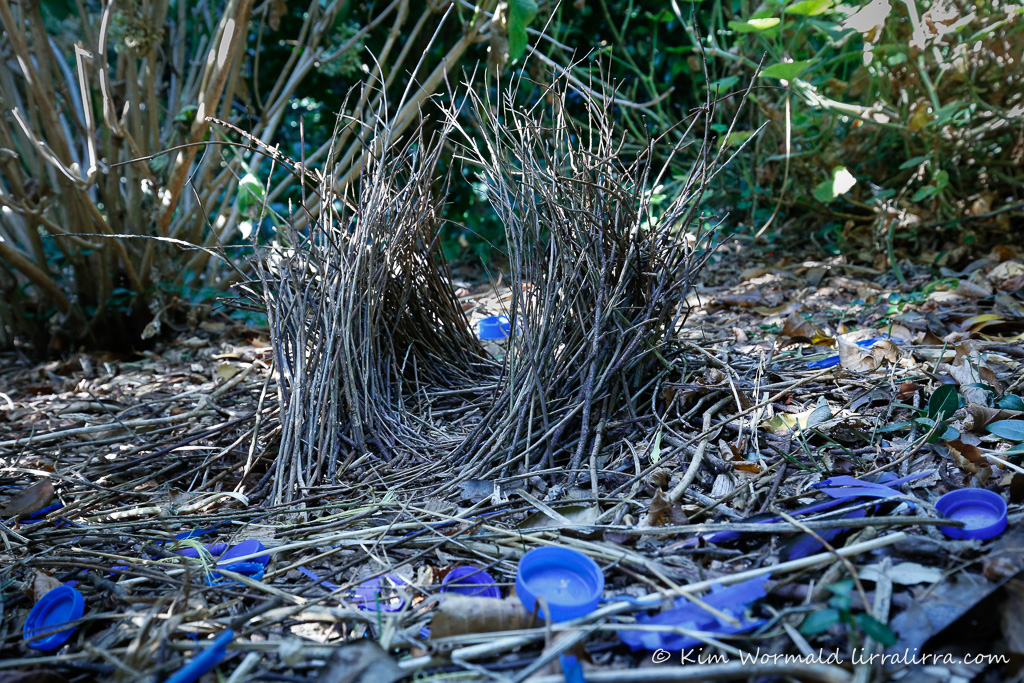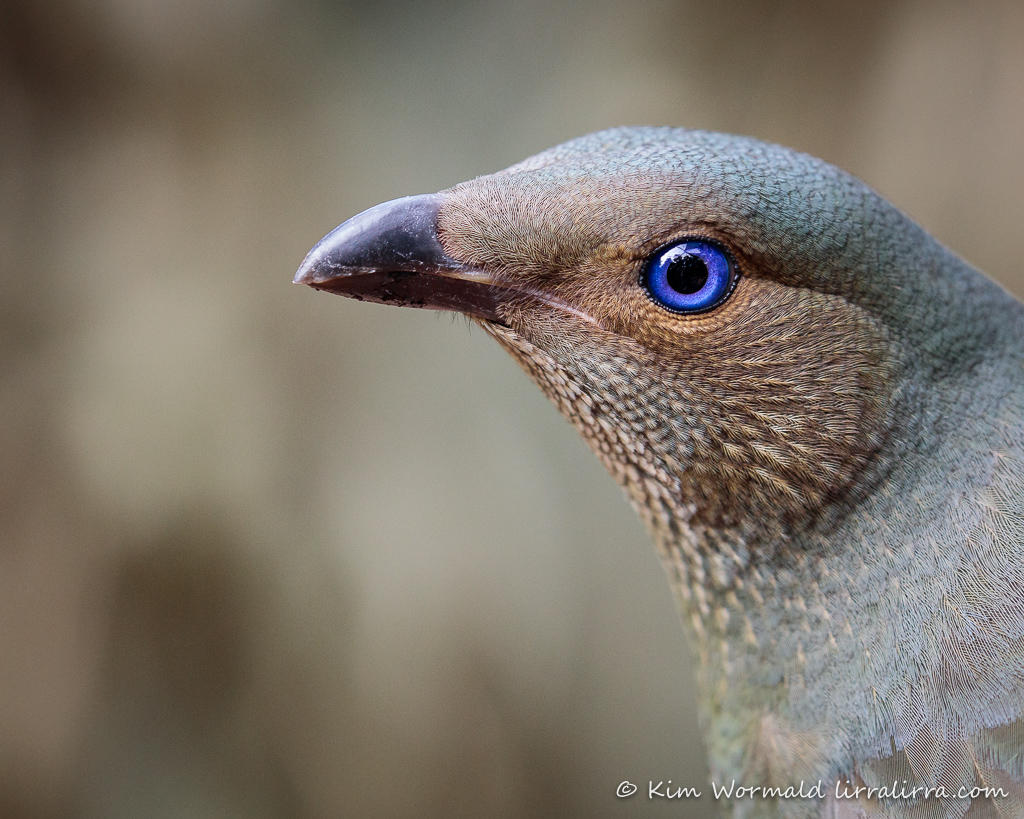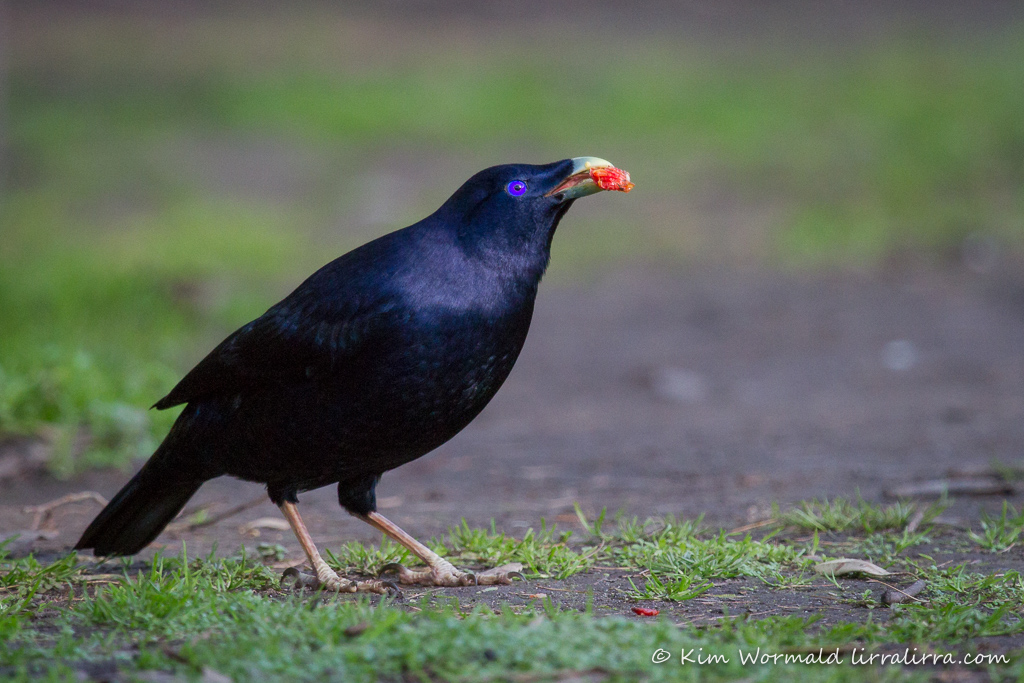It’s not every day that bits of rubbish are used so creatively, and that I leave where they are rather than popping them into the nearest bin.

Satin Bowerbird’s bower
1/80, f/8.0, ISO 1600
A friend mentioned this bower to me, so I went walkabout with two lovely family members and we managed to find it – thank you all.
Female Satin Bowerbirds build loose nests of sticks that can be up to 35m up a tree but before they get as far as egg-laying there is a lot of work undertaken by the male birds. The stick ‘stage’ is built by the male who carefully creates walls of sticks and decorates the area with blue items. This bowerbird has used bottle tops, straws, Crimson Rosella feathers, string and pieces of plastic among his collection.
The breeding season for Satin Bowerbirds is generally from September to February but male birds maintain their bowers throughout the year. If a female appears during the breeding season the male will put on a grand display, with exaggerated movements including stretching their wings, bowing and quivering while whistling and buzzing. If the female is charmed by his bower and behaviour then mating will take place in the ‘bed’ of sticks.

Satin Bowerbird (Ptilonorhynchus violaceus)
1/640, f/5.6, ISO 3200
Satin Bowerbirds are stunning. Females and young birds look similar and are known as ‘green birds’. The detail of their feathers and the blueness of their eyes is exquisite; I am mesmerised by the beauty of the bird above.
They feed mainly on fruit which is supplemented with insects during the breeding season and with leaves during winter. They measure about 30cm and weigh about 200g.

Satin Bowerbird (Ptilonorhynchus violaceus)
1/640, f/5.6, ISO 2500
Male Satin Bowerbirds develop their dimorphic colouring between the ages of 5 and 7 years. The image above was taken several years ago but is one of the only shots I have of an adult male – I think I need to hide myself in the bushes near the bower and update my male Satin Bowerbird shots.
I was interested to find out what these birds used as decorative items before their world gave them so many man-made options. According to information on the Australian Museum webpage, in areas away from human habitation they use predominantly blue parrot feathers and brown snail shells.
Happy birding
Kim
~ Prints and gifts Lirralirra Shop
~ Facebook page Kim Wormald – lirralirra
~ Facebook group Ethical Bird Photography
Season of Shame Update: This year’s opening weekend was quieter than last year but still saw shooters firing before the designated time. Many native waterbirds were killed and injured, including protected species, and many regional Victorians were traumatised. Rescuers were out in huge numbers to seek out wounded and abandoned birds.
Please sign and share this petition to add as many names as possible to the 60,000 who are calling for the Victorian duck shooting season to be banned: Animals Australia Petition
~ thank you for visiting and commenting
~ use the subscribe box if you’d like to receive a weekly email when lirralirra is updated

Thank you for sharing, these birds have always fascinated me and their bower building is just well, amazing! What nature thinks of….
Nature is truly amazing, now I’m wondering whether you have any similar species in the states …
With my love of the colour blue, perhaps I was a bower bird in a previous life!! Thanks for beautiful photographs, Kim.
I think there’s a good chance that you still are a bowerbird 🙂
Beautiful photos Kim. Like you, I am mesmerised by the colour of their eyes. Truly wonderful.
Thank you Neil! They are really beautiful
Beautiful photos. Thank you. Signed the petition.
Thank you Meredith, and many thanks for signing the petition
Perfect photos. Such beautiful eyes.
Thank you Susan, they are incredibly beautiful. One of my favourite things about bird photography is being able to examine such beauty at leisure
I did not know that Bowerbirds occur in Victoria! Thanks heaps!
I hope you get to see some Jona, soon
Hi Kim – what a great write up and a really incredibly beautiful portrait shot. As you say, a mesmerising beauty 🙂
I thinking I might enter the portrait in some international salons. I like being able to share images of our birds, hopefully some judges will find it mesmerising too 🙂
nice shot of the female kim. such great detail of feathers and the blue eye is so strikingly rich
Thank you. I love being able to capture such exquisite details
Those incredibly blue eyes echo their collections. I have (many years ago) seen a bower and its creator and it is a memory I hug to my heart. Love your portrait.
Petition signed. Of course.
I thought about the link with the colour of the females’ eyes but it’s strange to think that the females wouldn’t know what colour their eyes are, unless they talk about it … now my thoughts are getting a bit left of centre
Thank you for signing the petition
Interesting behavior, excellent documentation. I did not know the male tended the bower throughout the year. The information about the decorative items used in areas away from human habitation was interesting too.
Thank you David. They would be a fantastic species to study at length. Wouldn’t it be great to be tapped on the shoulder and asked to put together a series of images …
Wow! The care with which they make their bowers is really remarkable. Such fascinating behaviour! The colour of the female’s eye is so striking. What an interesting post!
I’m glad you enjoyed the post, nature is fascinating